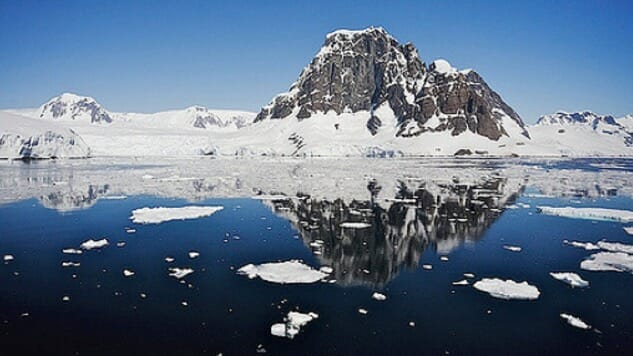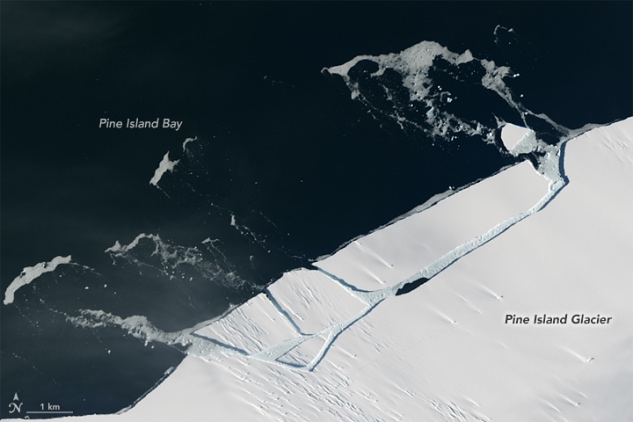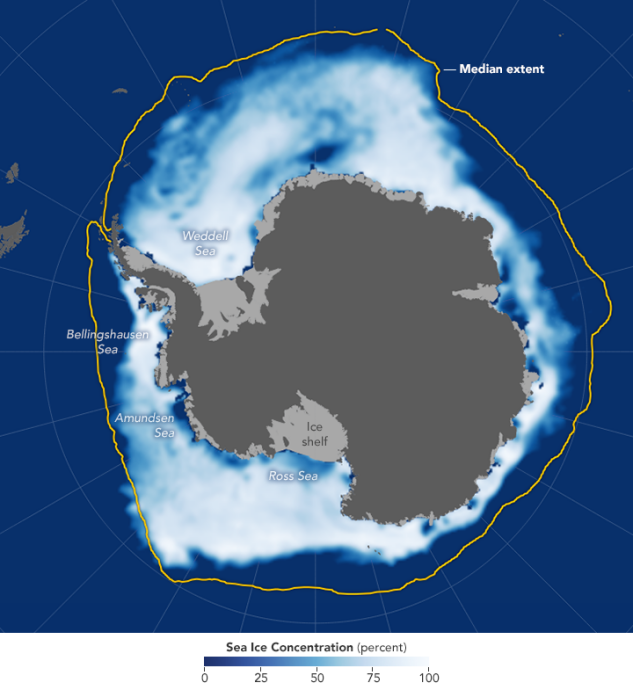
Often, when we talk about climate change, it seems like a far-off scenario. We talk in terms of saving the planet for future generations and predict disruptive sea level rise within the century. But the effects of climate change are already felt around the world; future changes will only intensify them.
![]()
Antarctica is, if you’ll pardon the expression, hot right now. There’s been plenty of news lately about enormous cracks in the ice shelf, glacier break-up and record-low sea ice. How do these recent changes relate to the larger phenomenon of climate change, though?
First, let’s talk about these different terms, so we’re all on the same page. Icebergs, glaciers, ice sheets and ice shelves are all made on land from snow or fresh water. Glaciers are ice formations found on land; icebergs are pieces of ice that break from glaciers and fall into the ocean (a process called “calving”).
An ice sheet is a kind of glacier, also called a continental glacier, that covers land in excess of 20,000 miles. What we call Antarctica is actually two ice sheets joined by a mountain range. Together, they form the largest body of ice on Earth.
An ice shelf is a floating slab of ice, attached to land, that is formed by a glacier or ice stream running down a coast into the water. It’s sort of a launching point for glaciers into the ocean—although as we’ve seen, ice shelves themselves can break off and form icebergs. Ice shelves are important because they can hold back a melting glacier like a dam. Once the ice shelf breaks off, it is far easier for a glacier to calve into icebergs.
Sea ice, on the other hand, is formed in the ocean; it is simply frozen ocean water. One kind of sea ice is called “multi-year ice,” which means it does not melt completely each year (or, at least, it’s not supposed to) and is rebuilt the following season.
![]()
Ice Shelves are Cracking Up
A mile-long chunk of ice broke off from Antarctica’s Pine Island Glacier in January. This glacier is notoriously unstable; previously, city-sized chunks have broken off, including a massive chunk in July 2015. Data provided by NASA indicates other rifts in the sheet that may mean more breaks in the future.
 Photo courtesy of John Sonntag/NASA
Photo courtesy of John Sonntag/NASA
Ian Howat, a glaciologist at The Ohio State University, compared this calving to an aftershock from the 2015 break. The same weaknesses in the ice shelf leading to that event, he said, likely caused this one as well.
Those weaknesses are very likely the result of warming water under the glacier’s ice shelf. (Remember, although ice shelves are attached to land, they float on water.) “The ocean under Pine Island Glacier’s ice shelf has warmed about 1°F since the 1990s,” Climate Central reports. The warmer water under the ice shelf causes it to melt from within. It weakens, cracks and slides off into the ocean.
Another big news item has been the 110-mile-long—and growing—crack in the Larsen C ice shelf. A chunk the size of Delaware could break off this year—and it could lead to other “aftershock” icebergs like we’ve seen with the Pine Island Glacier.
In addition to warmer waters under the shelf, Larsen C might be melting from above. Its sibling, Larsen B, collapsed in 2002. Before it shattered, lakes and ponds formed on the top of the ice, probably because of warmer weather patterns over the continent; eventually, the warmer waters on top and beneath the shelf met, and the huge shelf calved into several icebergs. Larsen C could suffer the same fate.
While it’s normal for glaciers to calve, these huge changes are occurring faster than normal—as much as five to ten times faster. While it’s difficult to attribute one or two calving events to a larger pattern of climate change, such a speed-up could be related to warmer global temperatures. And, because glaciers are formed from fresh water, adding icebergs to the ocean will result in sea level rise and disrupt currents.
![]()
Sea Ice Dips to Record Lows
For those who doubted or denied the existence of climate change, the sea ice around Antarctica provided a compelling case. Sure, the Arctic was melting. But down at the other pole, sea ice was actually growing. In 2014, sea ice floating around Antarctica extended as far as it had since 1979, when we first began keeping records. Perhaps that meant climate change was not happening.
Scientists would respond that Antarctica, which is very difficult to monitor and study, represents complex systems that are difficult to predict. There is never complete certainty in climate predictions; the planet is edging into new territory, and scientists don’t know the exact chain of events as the earth warms—especially when you consider multiplying effects and tipping points.
Furthermore, as I’ve mentioned before, climate change doesn’t necessarily mean a hotter globe everywhere; a warm Arctic might mean a beyond-frigid Siberia, at least in the short term.
Now those who used the growing Antarctic ice as a defense for climate denialism may find themselves on thin ice. Data recorded by the National Snow and Ice Data Center on February 13 and 14 indicated the floating ice around the snowy continent shrank to its lowest recorded extent. And, since the Antarctic summer is not yet over, it seems very likely ice will shrink even more before the year is out.
 Photo courtesy of Joshua Stevens/NASA
Photo courtesy of Joshua Stevens/NASA
This news doesn’t prove that climate change is driving sea ice melt, just as expanding sea ice didn’t disprove the existence of climate change. However, it is an important reminder that
sea ice formation and Antarctic weather patterns are complicated and not reduced to easy answers—which is important to keep in mind for future assessments.
However, Claire Parkinson, a senior scientist at NASA’s Goddard Space Flight Center, says that sea ice can serve as a microcosm for climate change. “The planet as a whole is doing what was expected in terms of warming,” Parkinson said in 2014. Now that ice is on a downward trend, the predictions of climate scientists seem ever more prescient.
Sea ice formation and calving events are just two indicators of Antarctica’s health. But all of the changes taken together paint a picture of a rapidly changing continent.
Top image: Christopher Michel, CC-BY
Melody Schreiber is a freelance journalist based in Washington, D.C.